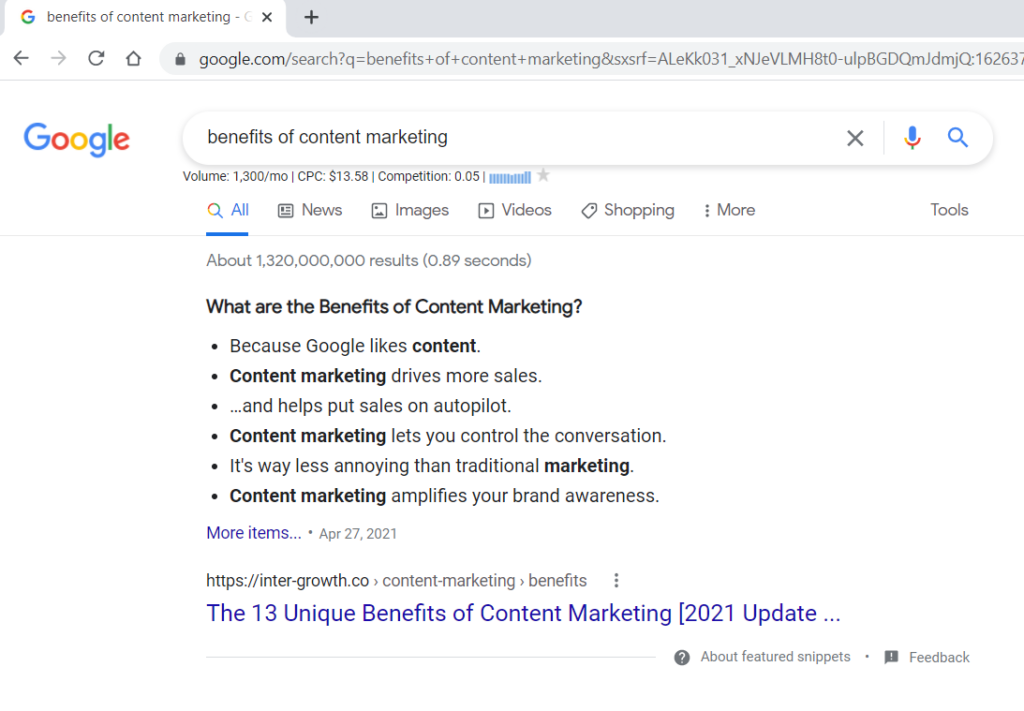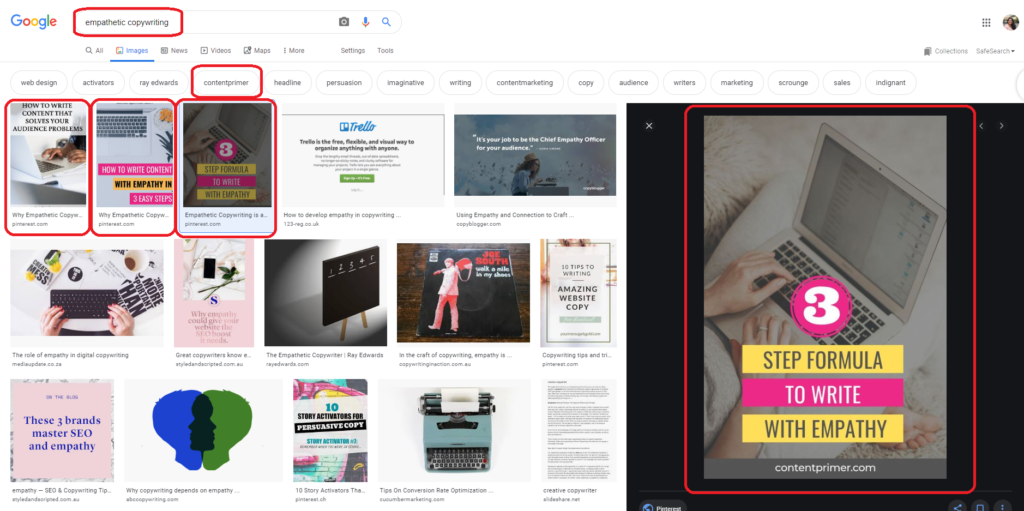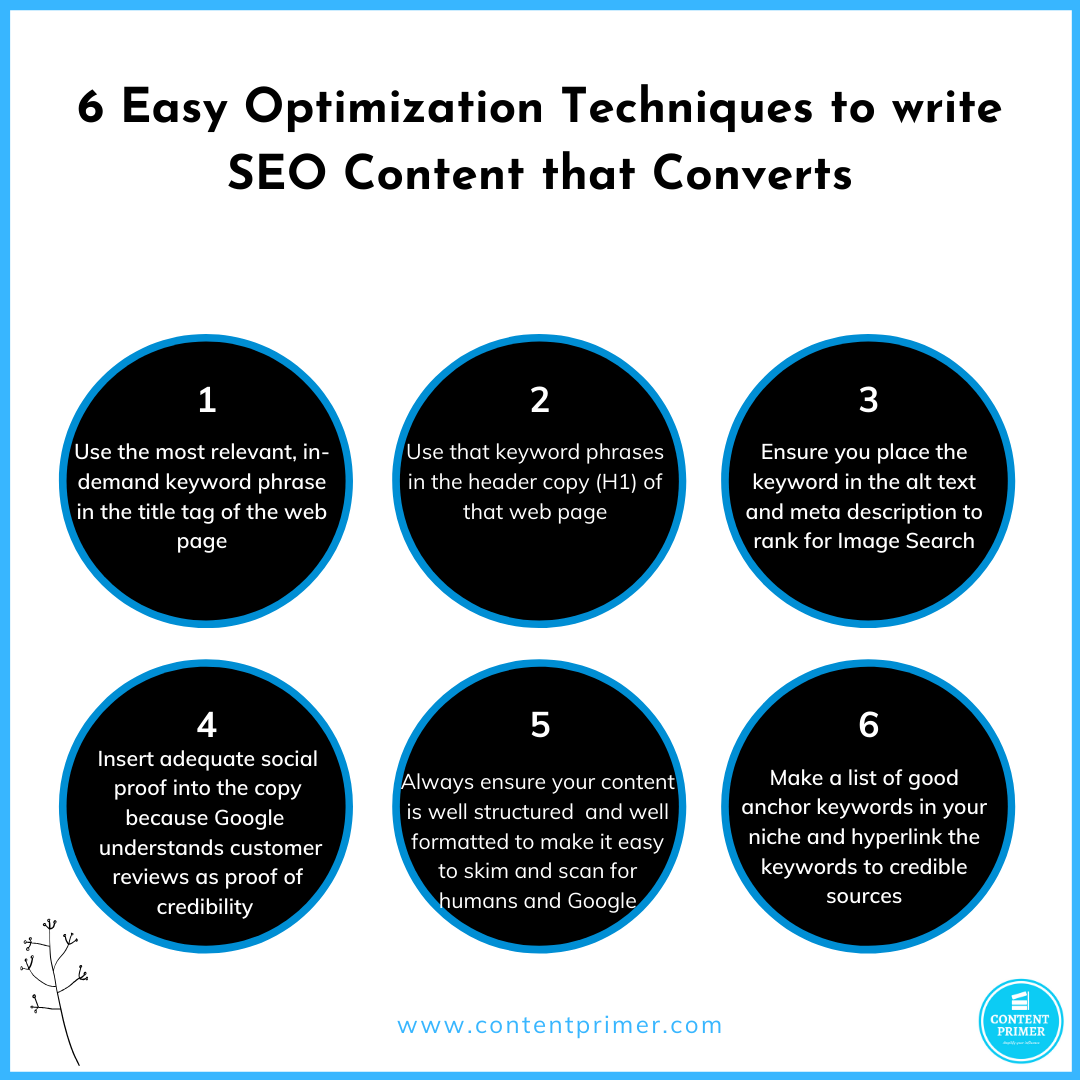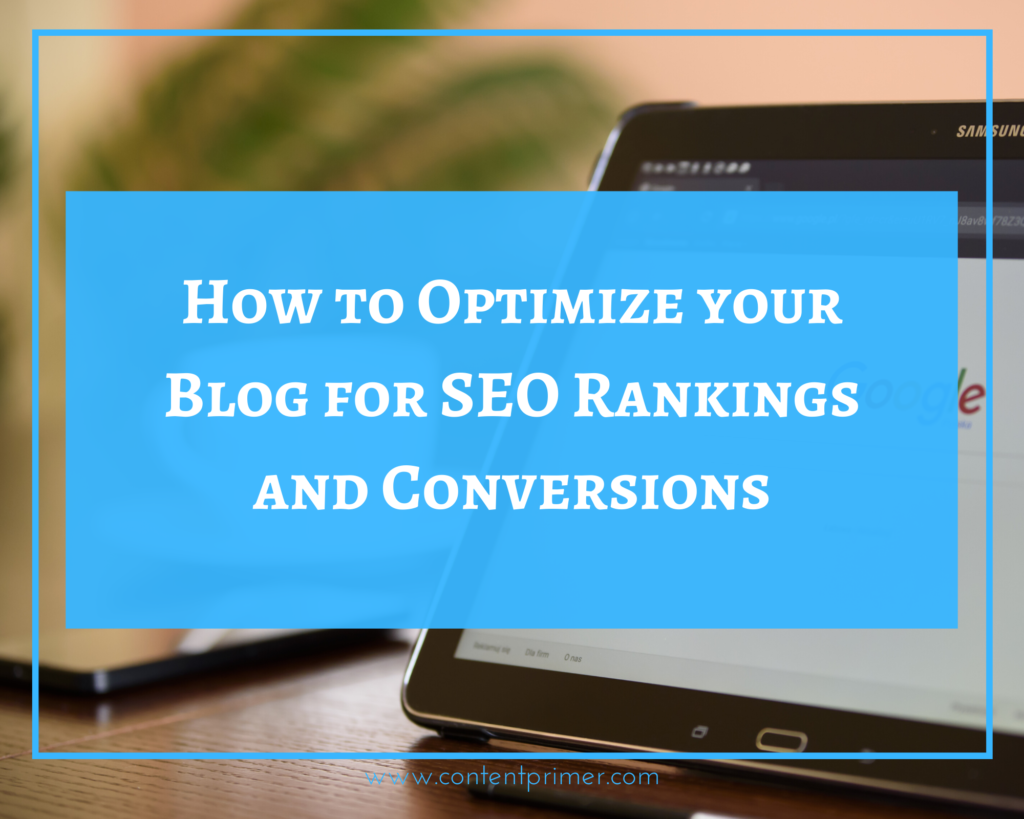When you Google the keyword “benefits of content marketing”, you notice that close to 1.3 billion blogs are fighting for the same keyword.

Visibility, credibility, and conversions – happen in that order in today’s attention economy.
Last year, I helped an LA-based e-commerce brand rank #1 on Google within days for high-competition keywords using the on-page SEO techniques I’m sharing in this blog.
Guess what? One year later, it’s still taking the top spot beating sites like Forbes and Entrepreneur. Even though the founder has stopped publishing new content.
Last month, I helped a logistics intelligence SaaS brand to rank #1 on Google within days instead of months for a popular keyword in the supply chain space beating billion-dollar sites like FedEx and UPS.
This happened within 5 days.
Day 1: The blog goes live
Day 3: The blog appears on the first page of Google
Day 5: The blog ranks #1 on Google
And I get a message like this from the client.

So what’s the secret behind ranking #1 on Google consistently AND staying on top?
Strategy 101: Write for humans first
Optimize for search engines later.
The focus of your content should solely be – usefulness. Never deviate from this principle.
Because chasing search engine algorithms is not a strategy. Frameworks change all the time. Most growth hacks die before the data comes in. Tools like ChatGPT are making educative TOFU content almost redundant. So how do you establish authority, consistently rank #1 on Google, 5x your organic traffic engagement, and freeze your churn? By connecting with the reader, conveying the right message at the right time, and converting them into brand loyalists.
Brand loyalists are people who come back to your brand/content over and over again.
Why?
Because they connect with your messaging.
Because they listen to what you have to say.
Because they find spending their precious time on your content worthy and valuable.
So…
Don’t listen to SEO tools like YoastSEO that encourage you to:
- Modify your tone because you started 3 consecutive sentences with the same word
- Stuff your headings with primary keywords even though it sounds unnatural
- Wishy-wash your introduction in a quest to fit in the primary keyword
- Inflate your content by suggesting inappropriate keyword density
So what should you do?
- Write like you speak, but don’t overdo it. Focus on your narrative
- Focus on being helpful to the reader
- Focus on guiding the reader to achieve the goal in the headline
- Go ahead and pick keywords with low keyword search volume if they bring value to your content
- Focus on holding a conversation with your reader
- Focus on making a logical argument and building a connection with your reader
- Create an SEO Content Strategy for BOFU keywords with navigational content
Because visitors who seek navigational content have high intent of purchase and are conversion-ready.
It also means that your content is in alignment with your visitor’s stage of awareness.
Once you plan and execute your content keeping the above strategy in mind, traffic flow becomes an after-effect of great content.
Now, how do you attract and convert this traffic?
Optimize headlines for SEO and Conversions
80% of your readers don’t read your copy if you can’t get them to read your headlines – David Ogilvy
Most of the content fails to grab the prospect’s attention because the headlines never offer the benefit the prospect is looking for:
- Are you helping your audience save time?
- Are you helping them bring down operational costs?
- Is your solution accessible from anywhere, anytime?
- Are you making their life easier?
If you said yes to any of the above, then you’ve got to mention that in your headline.
Treat each of your headlines like mini value prop statements.
The benefits should go straight into your value proposition to get your prospect interested FIRST.
Now, why is something as simple as highlighting benefits a deal-breaker?
Because the emotional benefit IS the real solution your visitors are here for.
So, strap the benefits to your headline.
Pro Tip: Ensure you optimize your title tag with the main focus keyword.
User-led Keyword Research
Google Crawlers are constantly looking for relevant keywords (the keywords you want to rank for) in your content.
The keywords your prospects are searching for.
But how do you predict what they’re searching for?
You don’t.
Lean back on the most recent user-generated content like:
- Sales call recordings
- VoC interviews
- Reddit threads
- Capterra/TrustRadius reviews
- Niche Slack Communities
The point is – don’t reinvent the wheel. Don’t second guess your content strategy by relying solely on tools like SEMRush or Ahrefs. Instead, lean on UGC to extract high-converting BOFU content and use these tools to improvise your keyword groupings. Create an SEO content strategy with topic clusters and keyword groupings to boost SEO and conversions.
Rank on Google by making your website accessible to a wider audience
Did you know that 20% of all organic searches are image searches? That’s a solid chunk of lead traffic if you harness it.
One of the Content Primer pages ranks #1 on Google Image Search for a popular keyword organically. You needn’t rely on Facebook ads or Google ads all the time to drive targeted traffic. Simple optimization techniques can help you achieve this with ease without inflating your marketing budget. Let’s find out how.
Look at the screenshot below.

If you see, the top 3 results on the search page are displaying images from Content Primer for the keyword empathetic copywriting.
If you inspect the page, you’ll find out that it’s optimized for Image search.

Alt text is the communication channel between your website and search engine spiders that help you rank. Alt text is also the communication channel that makes your content more accessible to a wide range of users including the ones who use accessibility tools like text-to-speech converters etc.
5 Strategies to optimize your images for Google
- Use descriptive file names and alt text
For example, the file name of one of the ranking images is “Empathetic-Copywriting-Content-Primer.png”
How to write descriptive file names
The file name here is the keyword we’re aiming for and the brand name. - Keep your file names and alt text brief but clear

How to write alt text descriptions the right way
The alt-text description here is pretty much the title of the blog. This implies that you should treat your alt text as mini value prop statements. Explain what the image signifies, for whom and what’s the benefit of following along. - Avoid generic file names like picture.jpg, image2.png, etc.
- Avoid lengthy, full-sentence file names
- Avoid stuffing keywords in alt text and file names
- Avoid using only image links for your site’s navigation
- Use standard image formats like JPEG, GIF, PNG, BMP, and WebP image formats
- Make your images mobile-friendly as 60.9% of all website traffic comes from mobile devices
How descriptive alt text and captions help rank #1 on Google:
- It indicates the purpose of the image and relays the exact content of the image
- Increases relevance to the content and brings clarity
- Specific information increases the chances of matching with the search keywords and bumps your page to the top
Tip: Run an instant SEO Audit of missing alt text images on your website now for FREE.
How to beat billion-dollar sites and rank on Google
One of the easiest ways to outdo giant websites on their own keywords is to:
- Create meaningful, helpful, read-worthy content
- Create useful, illustrative image content that cuts down the learning time for the reader
Let’s look at an example.
We were able to beat billion-dollar sites like FedEx and UPS on their own keywords and rank within days.
The blog takes the top spot on Google SERPs and is ranking for 44 keywords.
The target keyword is “fedex service guarantees”. My client’s blog was on the top spot for close to 18 months. It’s taking the 5th spot currently.

Write for the most distracted reader to arrive at interesting content

Humans are wired to react to interruptions.
The reason why mobile phone notifications are so easy to give into.
So how do you make your reader stay focused?
By using Pattern Interrupt Techniques.
Pattern interrupt is a psychological approach to shifting your reader’s focus and influence their behavior.
How can you use this psychological phenomenon to keep your readers interested in your content?
Create Disruptive Content Without Switching Context
Influence your reader before a notification takes that power away from your content. Make your content MORE interesting than their distractions – By dividing and displaying content differently. This is how:
- Ensure the headings carry appropriate H1, H2, H3 tags
- Use graphs and visual charts to make information more memorable
- Use screenshots to offer proof and explanation then and there
- Use snappy gifs to make content memorable
- Use bullets instead of a clunky text box
- Highlight to bring the focus back – bold, italics, underline, color
- Use images to explain instead of a long boring paragraph
- Use content highlighters like colored blocks
- Create carousel content to keep your audience hooked
- GIFs when used appropriately can pattern interrupt and make your content more interactive
User Experience and User Retention
The fundamentals of creating content for your audience is to be helpful.
Anchor text is the tool that makes the interwebs so powerful. It makes access to relevant information easy in just one click.
Linking to related topics in your content creates a content repository your audience comes back to for their other information needs.
To get anchor texts right, every time you create anchor text, connect back to the primary intent –
- Can this link introduce my readers to topics they need to know?
- Can this link open up new channels and learning experiences for my readers?
- Is this link connecting to a pre-requisite topic that’ll bring them closer to their desired outcome?
On the downside, too many external hyperlinks may take your audience away from your website. So, make sure that you’re bringing a balance.
Pro Tips: Never hyperlink your anchor text to your competitor's websites. Overdoing hyperlinks can also result in penalties by Google.
Summary: 6 easy steps to SEO Content to increase conversions

